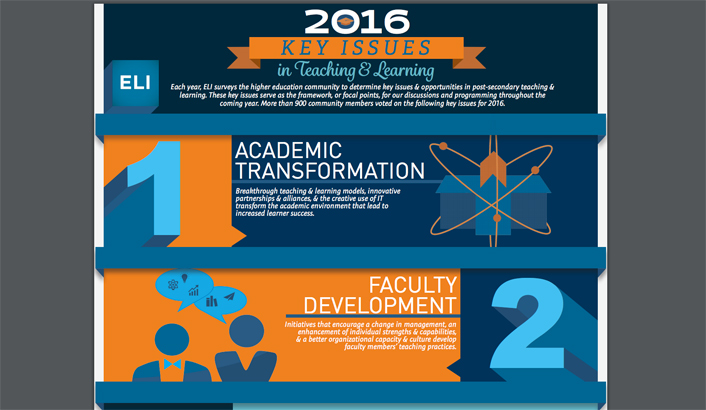
Once a niche field, edtech has grown to provide educators at all types of institutions with a bevy of options to assist in instruction and evaluation—and their target audiences are certainly interested in discovering and adopting new technologies.
They may be teaching online and blended courses, or serve on the faculty of institutions adopting iPASS strategies toward student success. They’re sharing what works (and what doesn’t) with their peers, their departments, and perhaps the greater campus community. These lifelong learners want to continually improve their practice—but they need the right support, training, and access to experts in order to accomplish that.
Not surprisingly, these evolving needs have transformed faculty development programs.
The EDUCAUSE Learning Initiative (ELI) recognizes the importance and the impact of such changes. Each year, ELI surveys the higher education community on key issues and opportunities in post-secondary teaching and learning—the results of which serve as the framework for discussions and programming throughout the coming year.
When ELI released its annual survey findings via infographic in early February, it was clear that faculty development—a topic with a seemingly ever-broadening definition—was a top priority. It received the second greatest number of community votes.
While hardly considered a newer ‘trend’, faculty development has evolved and branched out into new areas in recent years. Advances in technology have enabled universities to make a significant shift toward online and hybrid learning environments, which has incurred its own set of challenges and opportunities in the context of training faculty members.
Institutions of higher education have also underscored the importance of their most critical asset through offering tailored professional development. This may involve subsidizing external workshops and programs, or creating in-house sessions with guest speakers on topics like design thinking and innovation. An emphasis on impact and evaluating the efficacy of faculty development programs has become more pronounced as programs cross boundaries in terms of discipline and academic rank.
In a recent ELI Focus session, a presenter from McGill University offered an insight indicative of such a shift. “The question has changed from [asking faculty members] ‘What do you do?’ to ‘What difference do you make?’”
Yet many institutional leaders are grappling with the right frameworks for evaluation, and even a few obstacles to success, such as how to scale programs effectively, how to create alignment with incentives, or how to provide the right levels of technological and pedagogical support.
As hundreds of ELI community members voted to ensure that faculty development would play a major role in the organization’s 2016-2017 programming, ELI’s leadership team was listening.
In response, ELI assembled a number of offerings that cover a variety of faculty development needs and interests. Here’s a sampling of upcoming events and available resources:
- A suite of ELI Courses planned from mid-May to late August of this year tackles teaching-centered topics with a technology slant, covering everything from Teaching in Blended Learning Environments to Implementing Universal Design to Mobile Learning. With limited spaces available, a more personalized and high quality experience is offered to those registering soon.
- Investigating the future of the LMS has given rise to questions on tech capabilities, user experience, data integration requirements and other frameworks for developing a Next Generation Digital Learning Environment (NGDLE) that would suit the needs of higher ed’s varied stakeholders. The most recent Focus Session explored it in depth; in this NGDLE Resources Google Doc, one can find out how learning ecosystems might evolve to support both faculty and student populations. These would, as edtech professional Clint LaLonde stated in a recent blog post, “allow faculty to mix and match tools to fit their pedagogical needs. This gives faculty greater autonomy with what tools they want to see, while still being connected (with technologies like LTI & Caliper) to centralized institutional systems.”
Those interested in learning more can also access several publicly available reports, including:
- 7 Things to Read About Evaluating Faculty Development Programs, a rich compilation of ELI-produced multimedia and written materials that previously was only available to ELI members. Find out how to determine the effectiveness of your faculty development programs with an online seminar from faculty and staff at the University of Wisconsin system, or delve into this substantive report from a recent ELI Focus Session on Faculty Engagement and Development: Innovative Practice.
- An ELI paper on Faculty Engagement and Development: Innovative Practice spells out the new era of evaluating such programs effectively. The report examines models, tools and approaches in use within successful faculty development programs, and emphasizes securing buy-in from faculty and incorporating students’ voices as well.
- Educational Technology and Faculty Development, a publication from the EDUCAUSE Center for Analysis and Research (ECAR), shares findings from a diverse array of Carnegie classifications on ways in which faculty members are integrating technology into their teaching, how institutions are supporting them in this practice, and how students are receiving their efforts.
Kristi DePaul is marketing manager, EDUCAUSE Learning Initiative (ELI) and Next Generation Learning Challenges (NGLC), at EDUCAUSE.
